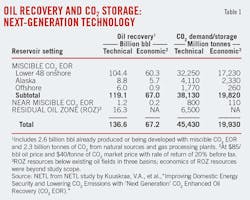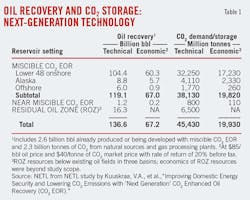Research sponsored by the US government seeks development of new chemical methods for improving mobility and conformance of carbon dioxide floods in enhanced oil recovery.
A report published late last year by the Department of Energy's National Energy Technology Laboratory (NETL) reviewed 40 years of research on applications using thickeners, foams, and gels in one of several next-generation technologies considered crucial to realizing the potential of CO2 EOR.
A revised resource assessment conducted by Advanced Resources International for DOE last year estimated the potential at 137 billion bbl of technically recoverable oil and 67 billion bbl economically recoverable at an oil price of $85/bbl (Table 1). Achievement of the economically recoverable potential would require purchase by operators of nearly 20 billion tonnes of CO2, of which at least 18 billion tonnes would have to be of human origin captured from coal-fired power plants and other industrial sources. The economically recoverable volume could support production of nearly 4 million b/d of oil, NETL said.
In addition to improved CO2 mobility ratio and flood conformance, key next-generation technologies include increasing CO2 injection volumes by 50% or more, drilling horizontal wells for injection or production, extending the conditions under which miscibility between oil and CO2 can be achieved, and applying advanced methods for monitoring flood performance.
For CO2 mobility control, which addresses high CO2 mobility in comparison with oil and water, current practice favors water-alternating-with-gas (WAG) injection strategies. To control CO2 flood conformance, current practice emphasizes mechanical techniques such as cement, packers, well control, infield drilling, and horizontal wells.
Gels and foams
In its literature review, NETL found "considerable" lab-scale progress in direct thickening of CO2, especially with the fluoroacrylate-styrene copolymer polyFAST and silicone oil-toluene solutions. It also identified successful lab-scale tests of water-soluble surfactants capable of stabilizing CO2-in-brine foams.
It said the emergence of robust gel-based conformance techniques coupled with WAG for mobility control "may have led to a decline in the use of foams as a conformance control technique, especially in extremely high permeability flow paths where foams are generally ineffective." The techniques include monomer solutions that polymerize and cross-link (gel) in situ, polymer solutions that cross-link in situ, foams that gel in situ, and preformed particle gel dispersions.
"These gel methods appear to be more effective and robust than CO2 foams, as demonstrated in a series of generally successful field tests conducted beginning in the late 1970s and continuing to the present day," NETL said.
Many lab-scale studies addressed the design of in-depth mobility control foams, leading to two pilot tests aimed solely at CO2 mobility control. One of the tests indicated that a 60% increase in the apparent viscosity of CO2 occurred where foam formed. Several pilot tests were designed not only to increase the apparent viscosity of CO2 but also to block a high-permeability zone. One test showed that CO2 foams could simultaneously enhance conformance control and mobility control. NETL noted that in Snorre field in the Norwegian North Sea alternating injection of surfactant slugs and hydrocarbon gas slugs has boosted oil recovery by an estimated 1.6 million bbl.
Lab tests and a current pilot test recently have successfully tested CO2 foams generated with CO2-soluble nonionic surfactants. And lab-scale testing has begun of foam stabilization with water-dispersible nanoparticles.
"The results of 40 years of research and field tests clearly indicate that mobility and conformance control for CO2 EOR with thickeners, foams, and gels can be technically and economically attainable for some fields; however, significantly more research needs to be conducted to improve the technology and the economics," NETL said.
Game changers
The study identified several "game changer technologies" representing promising candidates for further research. They are:
• CO2 viscosifiers. Recognized as a potentially important improvement for 25 years, an affordable CO2 thickener has yet to be developed. The ability to vary thickener concentration would enhance mobility control. Viscosity change via a thickener would not depend on subsurface conditions and fluid characteristics, as CO2 foams do. Thickener design has proven to be challenging because of low or complete CO2 solubility of compounds that contain the chemical groups responsible for viscosity-enhancing intermolecular associations, the NETL study said. Because promising CO2 thickeners tend to be solid at ambient temperature, it added, operational constraints will require researchers "to begin to investigate the process engineering aspects of field operations while continuing to seek a low-cost thickener."
• Near-wellbore conformance control with CO2 foams and gels. Although operators generally see CO2 conformance-control foams as less expensive than gels and more readily reversible, gels have been more successful in formations with fractures or highly permeable open flow paths. Foams, however, can be designed for conformance or mobility control, or both. NETL said, "It may be prudent to combine the two technologies where gels are employed for conformance control and CO2-in-brine foam (rather than WAG) is used for mobility control."
• In-depth mobility-control CO2 foams. Because gels are designed to dramatically increase viscosity, they can't be used for mobility control. That leaves surfactant-alternating-with-gas (SAG) as a potentially viable alternative to WAG. Also, interest has revived in CO2-soluble surfactants, which ensure that surfactant appears and foam forms only where CO2 flows. CO2-soluble surfactants are being field-tested at Scurry Area Canyon Reef Operators Committee oil field (SACROC) in West Texas. And injecting nanoparticles instead of surfactant might solve problems of long-term instability and surfactant adsorption loss.
Research projects
Through the NETL, the Department of Energy's Office of Fossil Energy in 2010 sponsored research projects aiming to further next-generation CO2 EOR to the point of pilot-scale testing.
At the University of Texas (Austin), researchers are evaluating inexpensive alternative nanoparticle sources for large volumes needed for foam stabilization in field-scale CO2 floods. Under study are low-cost, commercially available bare silica nanoparticles coated with polyethylene glycol and natural nanoparticles such as fly ash to develop CO2 foam.
Research at the New Mexico Institute of Mining and Technology focuses on the use of nanoparticles to increase CO2 flood sweep efficiency.
Another study at the University of Texas focuses on development of mobility control agents using surfactants injected with CO2 rather than with water in heterogeneous carbonate and sandstone reservoirs.
Other studies are field-testing gels for conformance control and developing advanced computer simulation and visualization capabilities for CO2 EOR, an electromagnetic monitoring effort to track the CO2 flood front, and a field case study of an existing CO2 flood targeting the residual oil zone.
More Oil & Gas Journal Current Issue Articles
More Oil & Gas Journal Archives Issue Articles
View Oil and Gas Articles on PennEnergy.com

